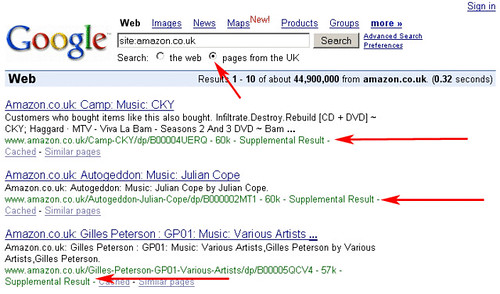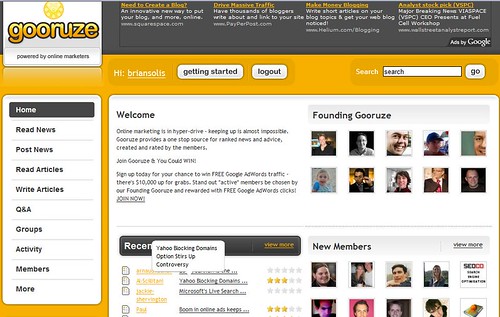 I’m often asked about the Google’s Supplemental Index (SI) and how to get pages out it. Consider this post directions to the exit, the light at the end of Google’s dark tunnel, the “this way to the egress,” if you will. (Ok, so I like my hype, but I promise it’ll be worth it.)
I’m often asked about the Google’s Supplemental Index (SI) and how to get pages out it. Consider this post directions to the exit, the light at the end of Google’s dark tunnel, the “this way to the egress,” if you will. (Ok, so I like my hype, but I promise it’ll be worth it.)
If you’re impatient, click here to get the solution to getting your page/pages out of the Supplemental Index and skip the background info. I think you’re better off with a full understanding of the SI, but I’ll leave it up to you.
As Aaron Wall puts it in his excellent SEO Book, search engines are frequently developing new ways to save computing power. When you do things on a large scale and have billions of websites and web pages to work with, as Google does, getting your computers to run more efficiently will save you money. Lots of it. The Supplemental Index is a way for Google to save money by being more efficient with its computing.
To understand how to get your pages out of the Supplemental Index, you need to understand why they’re there to begin with. In other words, you need to know how the SI works. So let me explain.
When somebody performs a search with Google, what happens behind the scenes is something like this.
- Google looks at the keywords.
- It compares them to the pages in its index (think of a library’s index card system).
- Google determines which pages are most relevant and ranks them.
- Finally, the results are displayed to the searcher.
It’s incredible, but Google really does do all that in fractions of a second.
(This is a simplified explanation of Google’s processes, based on what Dan Thies wrote at SEO Fast Start. If anyone has the precise page’s link, I’d appreciate a comment pointing it out, as I’ve lost it. Wouldn’t want that page to end up in the Supplemental Index, now would I?)
The second part of the process gets exponentially more expensive for Google every day, as more sites and pages go online. Their computers need to run through more and more content. Google hit upon the idea of using a Supplemental Index as a shortcut in this process. By putting pages of lesser importance in the SI, Google has fewer pages to assess and rank at step two. (Then, only if Google feels its main index has too few pages to allow it to do a good job, will Google resort to the Supplemental Index. It supplements their main index when this one is thin for a particular topic.)

Amazon also had Supplemental Index issues at one point, as Tamar Weinberg pointed out in this picture. It’s nothing to feel bad about. (Note that Google no longer labels pages in the supplemental index as such.)
So how does Google determine if a web site or web page is of lesser importance? The behemoth of search considers how likely a web surfer is to arrive at that page if they randomly click links in a never ending browsing session. The more likely someone is to visit your page through links on other websites and on your own, the more important your page. This idea is the foundation of Google, better known as PageRank. See Danny Sullivan’s article on PageRank (which he seems very enthusiastic about ranking for the keyword “PageRank,” based upon his linking practices on Search Engine Land) for more info.
The solution to getting your web page (or web pages, as the case may be) out of the Supplemental Index is to get more links to them. These can be links from within your own website, but it’s usually better – particularly with newer, less established sites – to get links from other websites.
If your site is non-commercial, it generally shouldn’t be difficult to get other sites to link to your inner pages, increase your PageRank and help you out of the Supplemental Index. But if your site is commercial, people are generally less willing to link to your pages. For example, the average webmaster (who isn’t an affiliate) has no incentive to link to a product page.
(As an aside, it would make sense for Google to count affiliate links towards determining whether a page belongs in the SI or main index. This despite the fact that they might be considered paid, PageRank manipulating links – which Google despises – otherwise).
So what do you do if you’re a merchant? (I owe this upcoming generous tip to Lorisa, who runs a Montessori schools materials site, featuring CD-Roms, teacher tools and more.)
Ironically, you create more pages!
Just not on your own website.
The pages you’ll create will be what’s commonly referred to as “User Generated Content.” For example, the photo-sharing site Flickr lets people upload pictures that then get an individual page (the picture at the top of this post comes from this Flickr user, as a matter of fact). Flickr’s users generate its content. And they link back to their own sites, or other pages they like, from their Flickr profiles, photo pages and so on.
A particular type of user generated content site – which I detailed in my article The New Directory – is likely more useful for getting these links than other types of site. This is because the quality of the user generated content is controlled by member ratings and reviews. While I again encourage you to read the article and learn more, I’m happy to provide you with the easy solution: a list of sites accepting user-generated content where you can get links to your site’s pages.
- Squidoo is a perfect example of The New Directory.

- Gooruze is similar, but focused on the internet marketing niche.
- SEOmoz is like a second home to me. I’d be crazy not to point out their great user generated blog Youmoz.
- Still in marketing, search marketing social media site Sphinn gives you a nice page – do see my profile and add me as a friend.
- eBay gives users About Me pages.
- Myspace is a classic and should need no explanation.
- Ezine Articles, for what it’s worth, lets you have a profile page. I’m not sure Google care much about Ezine Articles, though, because contrary to the New Directory, their quality control is nil.
- Dofollow blogs allow you to leave comments where the author’s name links to a page of his/her choosing. These links are counted by Google, as opposed to most blogs, which use nofollow (I’ll implement dofollow once I choose the right plugin). Courtney Tuttle has a good list of Dofollow blogs.
- WordPress lets users create blogs of their own on their site. (I also recommend using the WordPress software if you want your own full-featured blog with plugins such as dofollow. This blog runs on it.)
- PR offers free press release distribution. I’d link to PR Web too, but they don’t offer a free service, so no link love. (Told you being commercial was tough!)
- Search for “your product” and “social networking” on Google. Try related searches like “your industry” + “social networking,” “your industry” + “social media,” “your industry” + “forum(s),” “your product” + “file-sharing,” “your product” + “article distribution.” The sites you find will let you create a profile and links.
- At the end of the day, networking is still crucial, as I told Marketing Sherpa (PDF) (see tip #27). If you can get bloggers and journalists writing about you, that’s going to mean better links, traffic and copycat links from bloggers who repeat what they read in the daily paper.
Comments